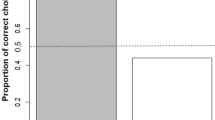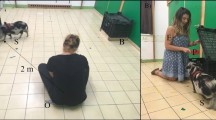Abstract
Some domestic animals are thought to be skilled at social communication with humans due to the process of domestication. Horses, being in close relationship with humans, similar to dogs, might be skilled at communication with humans. Previous studies have indicated that they are sensitive to bodily signals and the attentional state of humans; however, there are few studies that investigate communication with humans and responses to the knowledge state of humans. Our first question was whether and how horses send signals to their potentially helpful but ignorant caretakers in a problem-solving situation where a food item was hidden in a bucket that was accessible only to the caretakers. We then examined whether horses alter their behaviours on the basis of the caretakers’ knowledge of where the food was hidden. We found that horses communicated to their caretakers using visual and tactile signals. The signalling behaviour of the horses significantly increased in conditions where the caretakers had not seen the hiding of the food. These results suggest that horses alter their communicative behaviour towards humans in accordance with humans’ knowledge state.



Similar content being viewed by others
References
Byrne RW, Whiten A (1989) Machiavellian intelligence: social expertise and the evolution of intellect in monkeys, apes, and humans. Oxford Science Publications, New York
Call J (2001) Chimpanzees social cognition. Trends Cogn Sci 5:388–393
Call J, Bräuer J, Kaminski J, Tomasello M (2003) Domestic dogs (Canis familiaris) are sensitive to the attentional state of humans. J Comp Psychol 117:257–263
Feh C (2005) Relationships and communication in socially natural horse herds. In: Mills D, McDonnell S (eds) The domestic horse: the evolution, development and management of its behaviour. Cambridge University Press, Cambridge, pp 83–93
Gácsi M, McGreevy P, Kara E, Miklósi Á (2009) Effects of selection for cooperation and attention in dogs. Behav Brain Funct 5:31
Hare B, Tomasello M (2005) Human-like social skills in dogs? Trends Cogn Sci 9:439–444
Hare B, Call J, Tomasello M (1998) Communication of food location between human and dog (Canis familiaris). Evol Commun 2:137–159
Hare B, Call J, Agnetta B, Tomasello M (2000) Chimpanzees know what conspecifics do and do not see. Anim Behav 59:771–785
Hare B, Call J, Tomasello M (2001) Do chimpanzee know what conspecifics know? Anim Behav 61:139–151
Jakovcevic A, Elgier AM, Mustaca AE, Bentosela M (2010) Breed differences in dogs’ (Canis familiaris) gaze to the human face. Behav Proc 84:602–607
Kaminski J, Bräuer J, Call J, Tomasello M (2009) Domestic dogs are sensitive to a human's perspective. Behaviour 146:979–998
Krueger K, Flauger B, Farmer K, Maros K (2011) Horses (Equus caballus) use human local enhancement cues and adjust to human attention. Anim Cogn 14:187–201
Kusunose R, Tanaka T, Satou S, Kondo S (1995) The repertoire of behaviour. In: Sato S, Kondo S, Tanaka T, Kusunose R (eds) Ethograms of farm animals. Asakura Shoten, Tokyo, pp 18–97 (in Japanese)
Lampe JF, Andre J (2012) Cross-modal recognition of human individuals in domestic horses. Anim Cogn 15:623–630
Leblanc M-A (2013) The mind of the horse: an introduction to equine cognition. Harvard University Press, London
Levine MA (2005) Domestication and early history of the horse. In: Mills D, McDonnell S (eds) The domestic horse: the evolution, development and management of its behaviour. Cambridge University Press, Cambridge, pp 5–22
Maros K, Gácsi M, Miklósi A (2008) Comprehension of human pointing gestures in horses (Equus caballus). Anim Cogn 11:457–466
McKinley J, Sambrook TD (2000) Use of human-given cues by domestic dogs (Canis familiaris) and horses (Equus caballus). Anim Cogn 3:1322
Miklósi Á, Polgárdi R, Topál J, Csányi V (1998) Use of experimenter-given cues in dogs. Anim Cogn 1:113–121
Miklósi Á, Polgárdi R, Topál J, Csányi V (2000) Intentional behaviour in dog-human communication: an experimental analysis of ‘showing’ behaviour in the dog. Anim Cogn 3:159–166
Miklósi Á, Kubinyi E, Topál J, Gácsi M, Virányi Z, Csányi V (2003) A simple reason for a big difference: wolves do not look back at humans, but dogs do. Curr Biol 13:763–766
Murphy J, Arkins S (2007) Equine learning behaviour. Behav Proc 76:1–13
Nicol CJ (2005) Learning abilities in the horse. In: Mills D, McDonnell S (eds) The domestic horse: the evolution, development and management of its behaviour. Cambridge University Press, Cambridge, pp 169–183
Outram AK, Stear NA, Bendrey R, Olsen S, Kasparov A, Zaibert V, Thorpe N, Evershed RP (2009) The earliest horse harnessing and milking. Science 323:1332–1335
Passalacqua C, Marshall-Pescini S, Barnard S, Lakatos G, Valsecchi P, Previde EP (2011) Human-directed gazing behaviour in puppies and adult dogs, Canis lupus familiaris. Anim Behav 82:1043–1050
Pfungst O (1911) Clever Hans (The horse of Mr. von Osten): a contribution to experimental animal and human psychology. Henry Holt, New York
Proops L, McComb K (2010) Attributing attention: the use of human-given cues by domestic horses (Equus caballus). Anim Cogn 13:197–205
Proops L, McComb K, Reby D (2009) Cross-modal individual recognition in domestic horses (Equus caballus). Proc Natl Acad Sci 106(3):947–951
R Development Core Team (2005) R: a language and environment for statistical computing. R Foundation for Statistical Computing. Vienna. http://www.R-project.org
Sankey C, Henry S, André N, Richard-Yris MA, Hausberger M (2011) Do horses have a concept of person? PLoS ONE 6:e18331
Schwab C, Huber L (2006) Obey or not obey? Dogs (Canis familiaris) behave differently in response to attentional states of their owners. J Comp Psychol 120:169–175
Tomonaga M, Kumazaki K, Camus F, Nicod S, Pereira C, Matsuzawa T (2015) A horse’s eye view: size and shape discrimination compared with other mammals. Biol Lett 11:20150701
Udell MAR, Dorey NR, Wynne CDL (2011) Can your dog read your mind? Understanding the causes of canine perspective taking. Learn Behav 39:289–302
Virányi Z, Topál J, Gácsi M, Miklósi Á, Csányi V (2004) Dogs respond appropriately to cues of humans’ attentional focus. Behav Proc 66:161–172
Virányi Z, Topál J, Miklósi Á, Csánsyi V (2006) A nonverbal test of knowledge attribution: a comparative study on dogs and children. Anim Cogn 9:13–26
Virányi Z, Gácsi M, Kubinyi E, Topál J, Belényi B, Ujfalussy D, Miklósi Á (2008) Comprehension of human pointing gestures in young human-reared wolves (Canis lupus) and dogs (Canis familiaris). Anim cogn 11:373–387
Wobber V, Hare B, Koler-Matznick J, Wrangham R, Tomasello M (2009) Breed differences in domestic dogs’ (Canis familiaris) comprehension of human communicative signals. Interact Stud 10:206–224
Yamamoto S, Humle T, Tanaka M (2012) Chimpanzees’ flexible targeted helping based on an understanding of conspecifics’ goals. Proc Natl Acad Sci 109:3588–3592
Acknowledgements
Special thanks to the students of the equestrian club in Kobe University. We are grateful to Fuki Maehara for her support in our study’s video analysis. We also thank Dr. Shigeto Dobata for his support in the study’s statistical analysis. The study was supported by grants from the Japan Society for the Promotion of Science (KAKENHI Nos. 26118509, 15H01619 and 15H05309 to Shinya Yamamoto).
Author information
Authors and Affiliations
Corresponding author
Ethics declarations
Ethics
The experimental procedure for the horses was approved by the Institutional Animal Care and Use Committee (Permission number: 27-12-02) and carried out according to the Kobe University Animal Experimentation Regulation. All procedures adhered to the Japanese Act on the Welfare and Management of Animals.
Conflict of interest
We have no competing interests.
Additional information
An erratum to this article is available at http://dx.doi.org/10.1007/s10071-017-1074-x.
Rights and permissions
About this article
Cite this article
Ringhofer, M., Yamamoto, S. Domestic horses send signals to humans when they face with an unsolvable task. Anim Cogn 20, 397–405 (2017). https://doi.org/10.1007/s10071-016-1056-4
Received:
Revised:
Accepted:
Published:
Issue Date:
DOI: https://doi.org/10.1007/s10071-016-1056-4




